Physical Address
304 North Cardinal St.
Dorchester Center, MA 02124
Vascular surgery has evolved with the introduction of endovascular procedures. Minimally invasive laparoscopic techniques have also been developed, with a number of reports describing laparoscopic aortic repair for occlusive and aneurysmal disease. There are no large randomized trials to support laparoscopic aortic repair over open or endovascular surgery for abdominal aortic aneurysm (AAA) or aortoiliac occlusive disease (AIOD). The lack of trained vascular surgeons with the skills to perform laparoscopic aortic repair and the improved outcomes after aortoiliac stenting and after endovascular aneurysm repair (EVAR) led to question the need for laparoscopic aortic repair. There is, however, a subset of patients that will benefit from a potentially less invasive alternative to open repair when EVAR or iliac stenting is not achievable. In this setting, laparoscopic aortic surgery may be considered as an option.
We describe in this chapter the current laparoscopic techniques used for aortic reconstruction, including hand-assisted and robot-assisted laparoscopic surgery, their results, and the conditions required to master these procedures.
Four techniques have been described to perform total laparoscopic aortic bypass:
Retrocolic prerenal transperitoneal approach
Retrocolic retrorenal transperitoneal approach
Combined transperitoneal and retroperitoneal approach
Retroperitoneal approach.
The transperitoneal procedure described by Dion et al. and followed by Coggia et al. involves exposure of the aorta by a left prerenal approach. The patient is placed in the dorsal decubitus position with an inflatable pillow under the left flank. The left arm remains free and the right arm is placed on an armrest. The lower extremities are flexed and attached parallel to each other. Two supports are placed on the right side of the thorax and flank in order to retain the patient when the table is tilted to the right (45 degrees) and the pillow is inflated (35 degrees). After these maneuvers, the patient is in the complete right lateral decubitus position ( Fig. 64.1 ). It is possible to change the patient from the right lateral decubitus position, used during exposure of the aorta, to the dorsal decubitus position for exposure of the femoral arteries, simply by tilting the operating table.
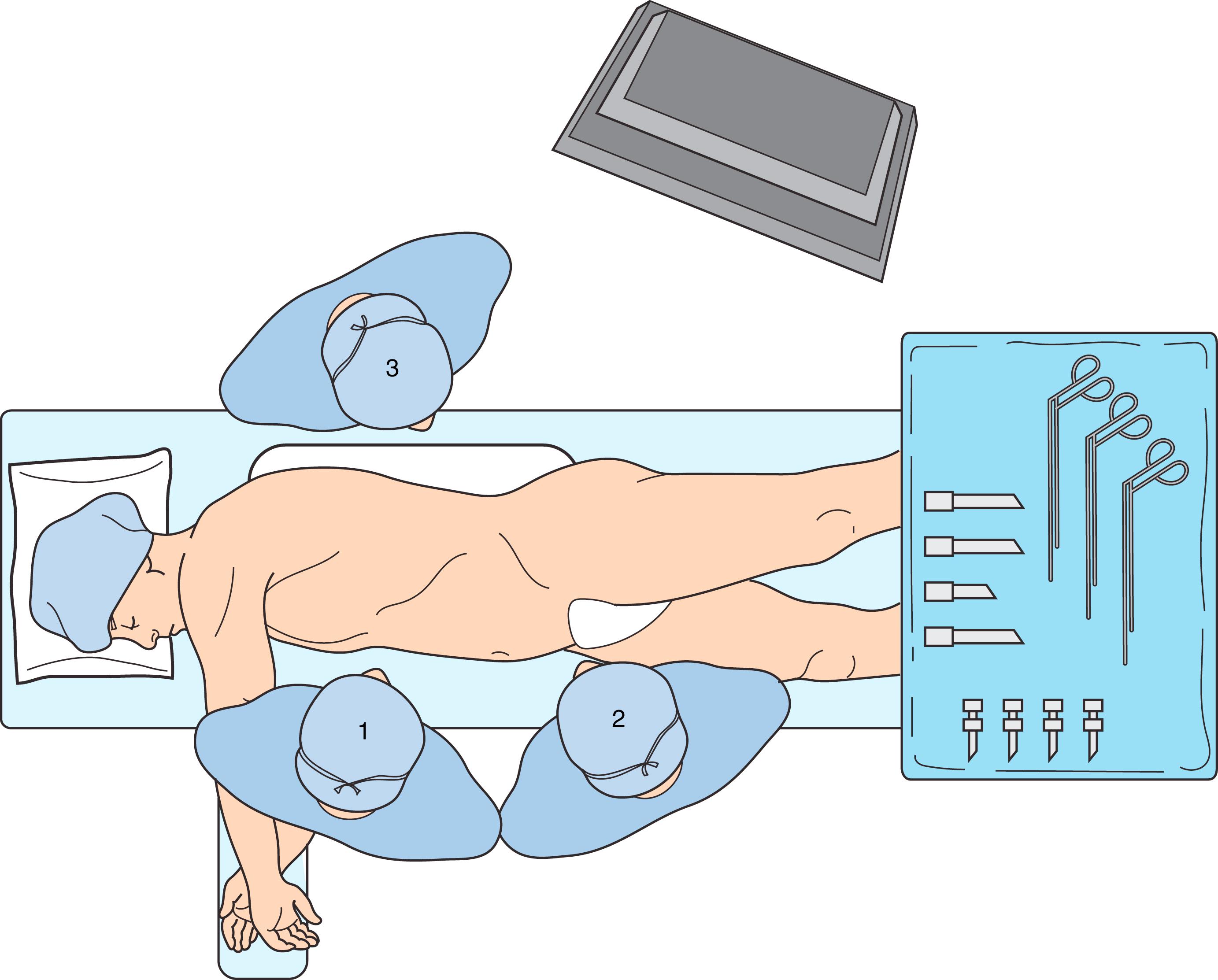
The operating surgeon and first assistant stand on the right side of the operating table, in front of the patient’s abdomen, and the second assistant stands opposite the operating surgeon. A pneumoperitoneum is insufflated up to 14 mm Hg through a Veress needle inserted in the left hypochondrium. A 45-degree endoscope is positioned on the left anterior axillary line below the costal margin. Five trocars are introduced under visual control after establishing a pneumoperitoneum. Two operating ports are placed 6–7 cm apart on the left transrectal line parallel to the midline (port #2 for scissors and needle holder and port #3 for fenestrated forceps). Two trocars for the first assistant are introduced in the left iliac fossa and on the midline 5 cm from the pubis (port #4 for suction catheter and port #5 for fenestrated forceps followed by distal clamp). The last trocar (port #1) is positioned on the midline, 2 cm below the xiphoid process for proximal aortic clamp) ( Fig. 64.2 ).
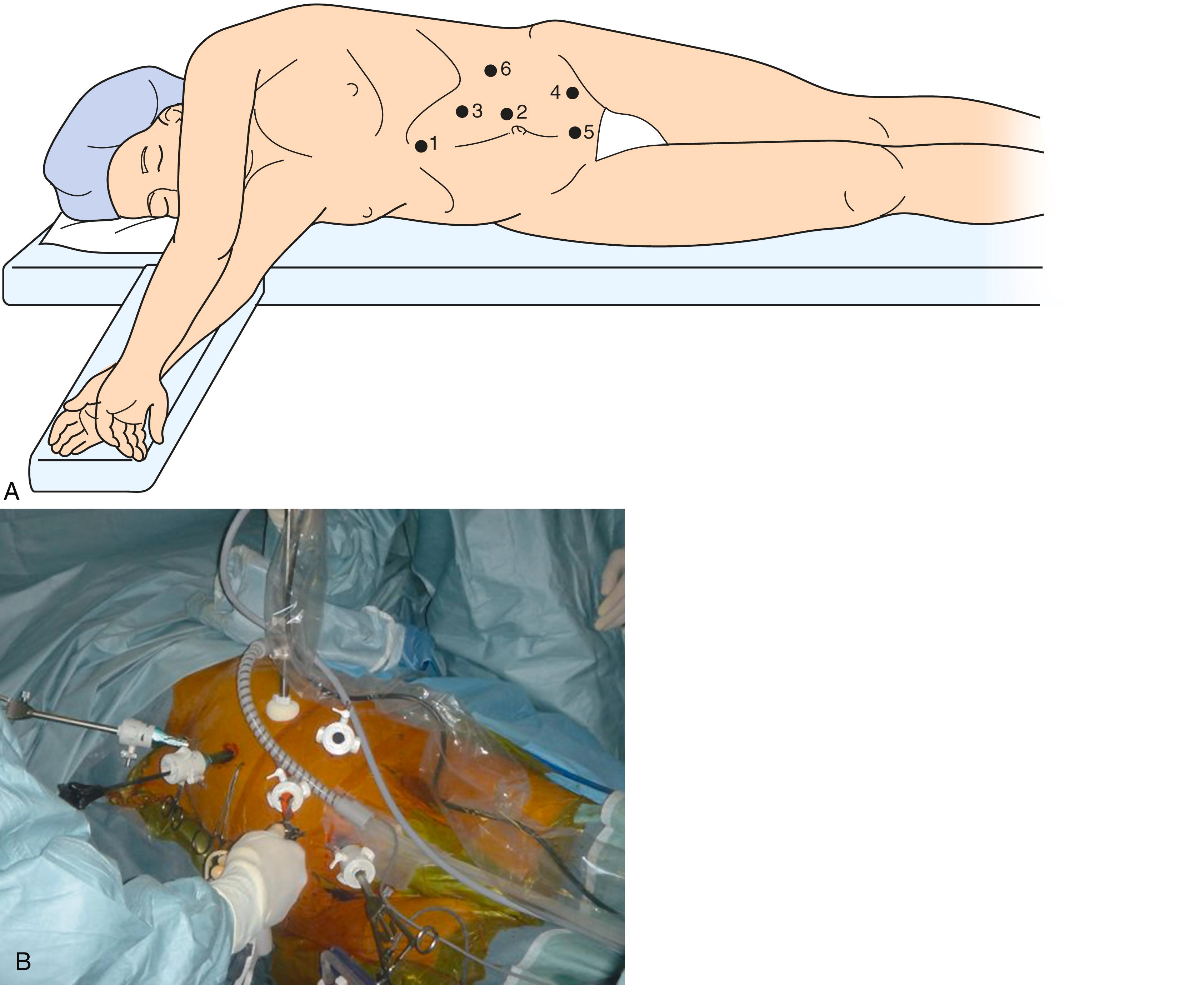
The left latero-colic approach involves left colic dissection to achieve prerenal exposure of the aorta. The table is tilted to the right (i.e., 45 degrees) and the pillow is inflated to enhance the right lateral decubitus position by 30 degrees. The Toldt fascia is incised from the left colic angle to the meso-sigmoid to allow complete dissection of the left mesocolon. After identification of the genital vein, prerenal dissection is continued to the left renal vein. Because the patient is in the right lateral decubitus position, the small bowel and left mesocolon drop to the right side of the abdomen ( Fig. 64.3 ). The mesocolon is then attached to the abdominal wall with transparietal sutures to form an apron providing stable exposure of the aorta. In case of extensive infrarenal aortic calcifications, mobilization of the renal vein is necessary to gain access to the juxtarenal aorta ( Fig. 64.4 ).
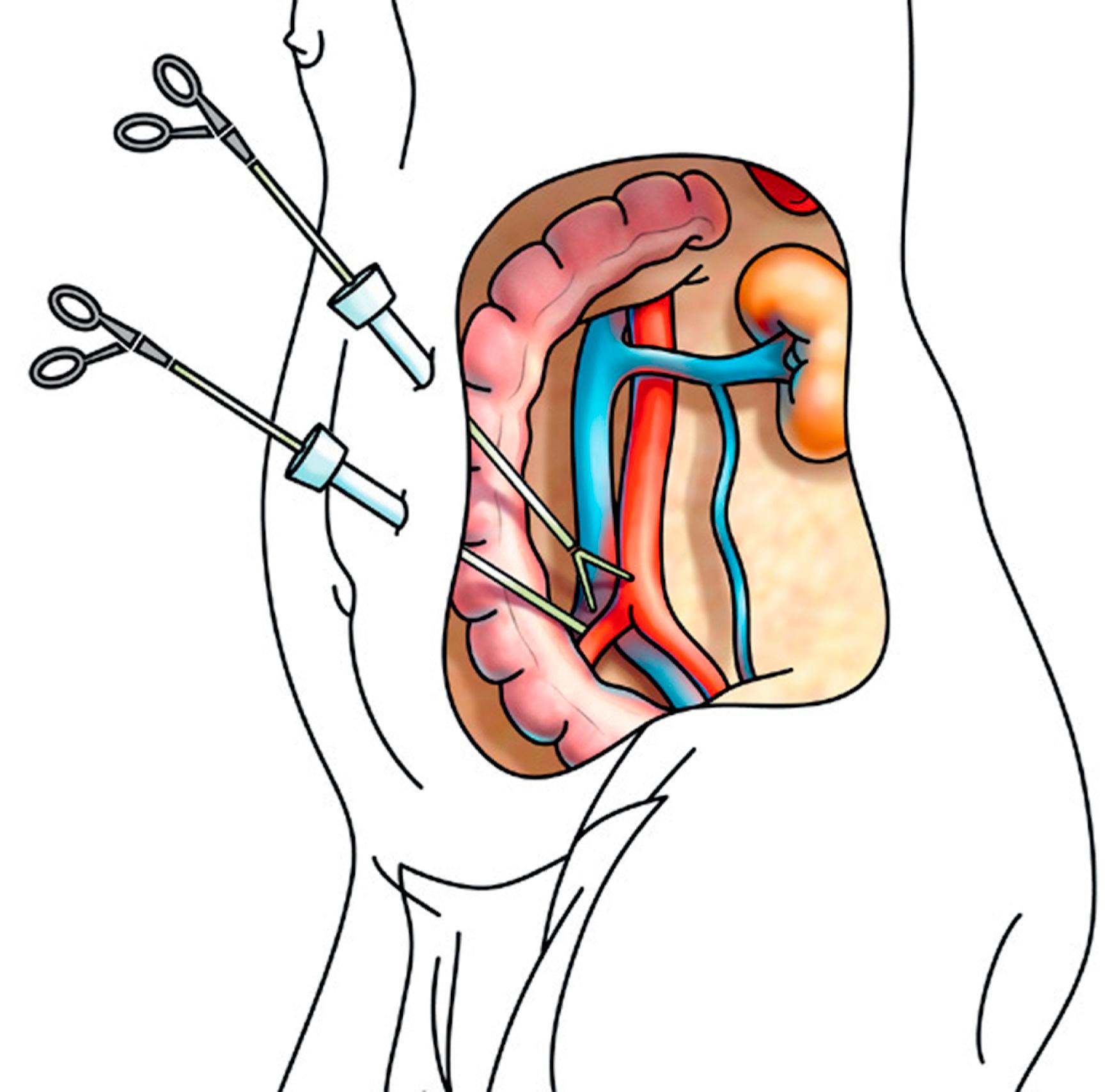
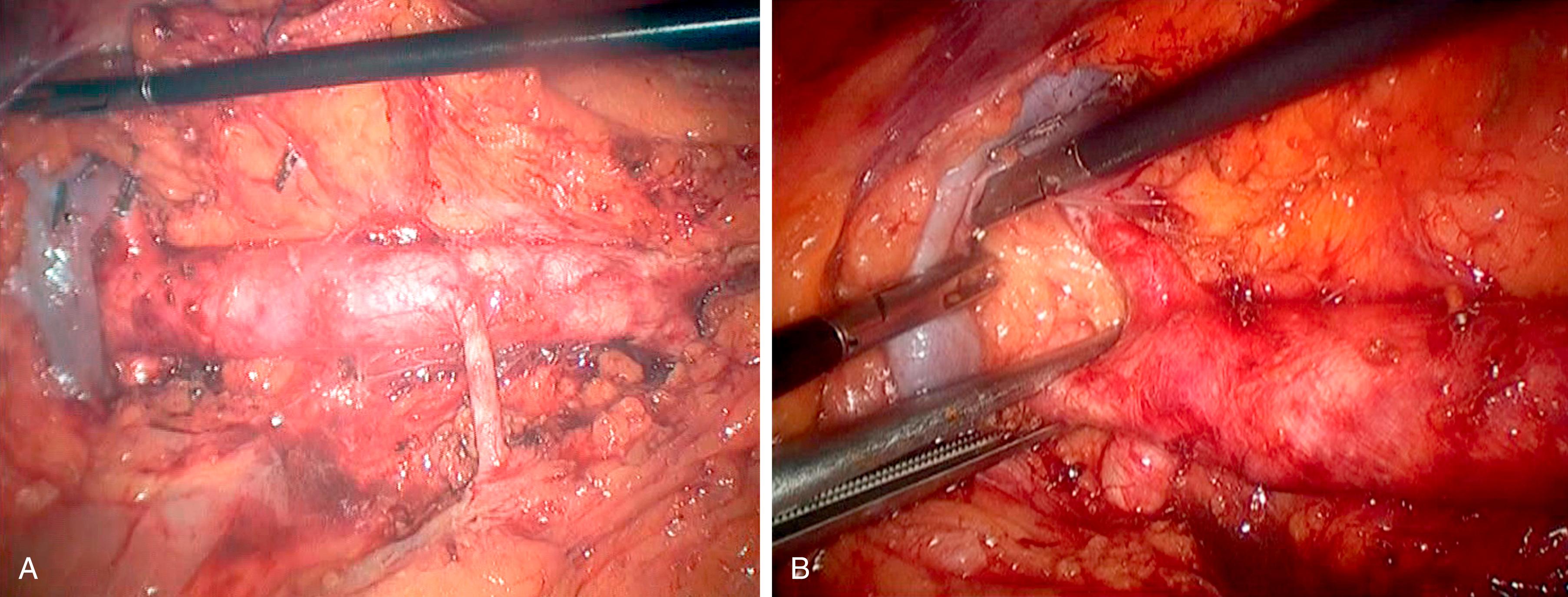
For exposure of the femoral arteries the table is rotated to the left and the pillow deflated. After conventional femoral exposure, the table is again tilted to the right to allow introduction of the bifurcated prosthesis through one of the ports. The right branch of the prosthesis is tunnelled in the anatomical position before making the proximal anastomosis. The extremity of the left branch is ligated and left in the abdomen.
Aortic clamping is performed with laparoscopic clamps introduced through ports #1 and #5, which stabilize the left colon during completion of the proximal anastomosis. The anastomosis between the aorta and prosthetic graft is made using 18-centimeter-long polypropylene 3/0 suture with one end previously sutured to a pledget to avoid tying the first knot ( Figs. 64.5 and 64.6 ). In case of an end-to-end aortic anastomosis, the closure of the infrarenal aorta is performed with a double running polypropylene 3/0 suture. One alternative is the use of an automatic stapler without cutting knife (Endopath ETS-Flex 45, Ethicon) which saves time but requires a moderate calcified aortic wall.
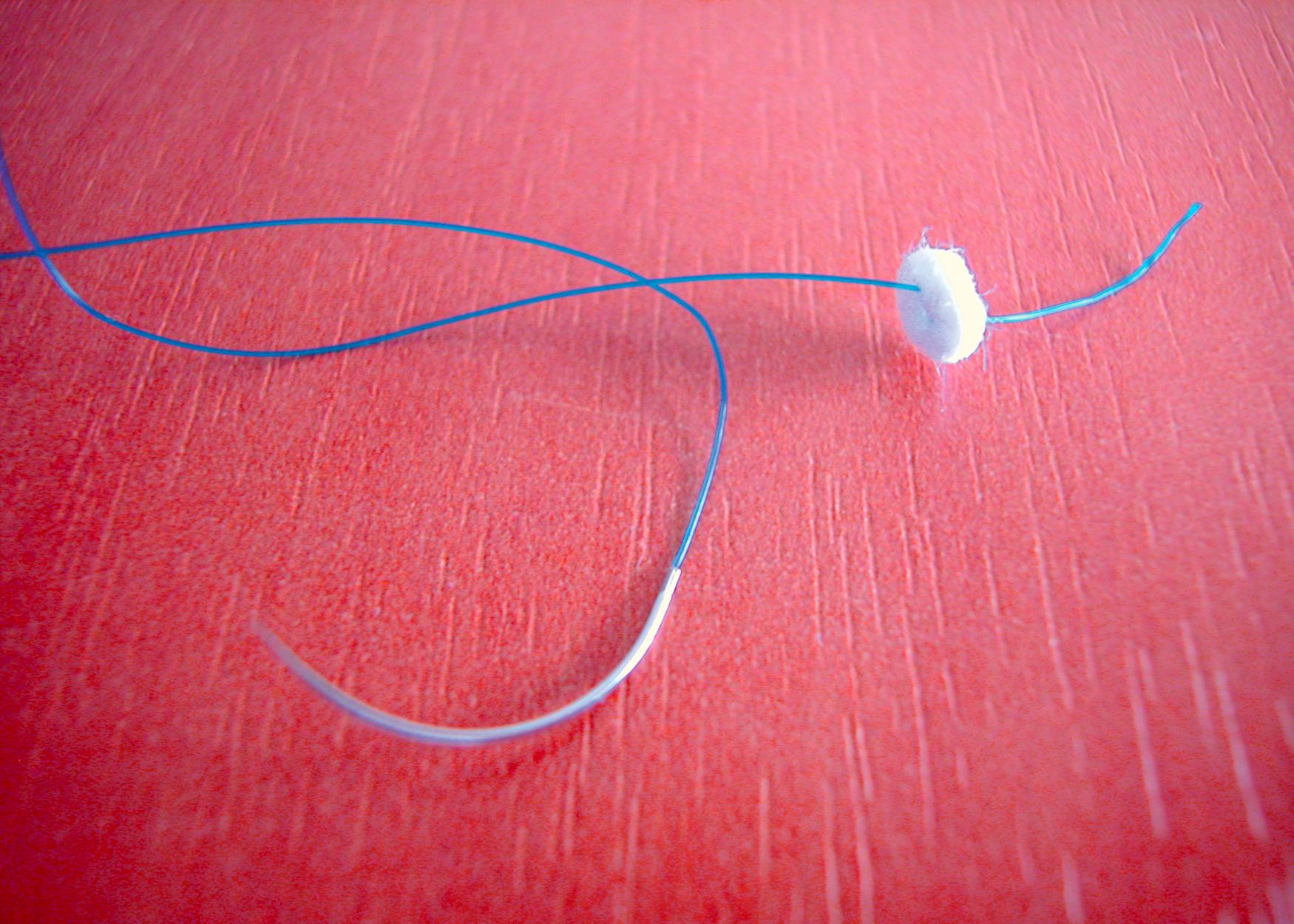
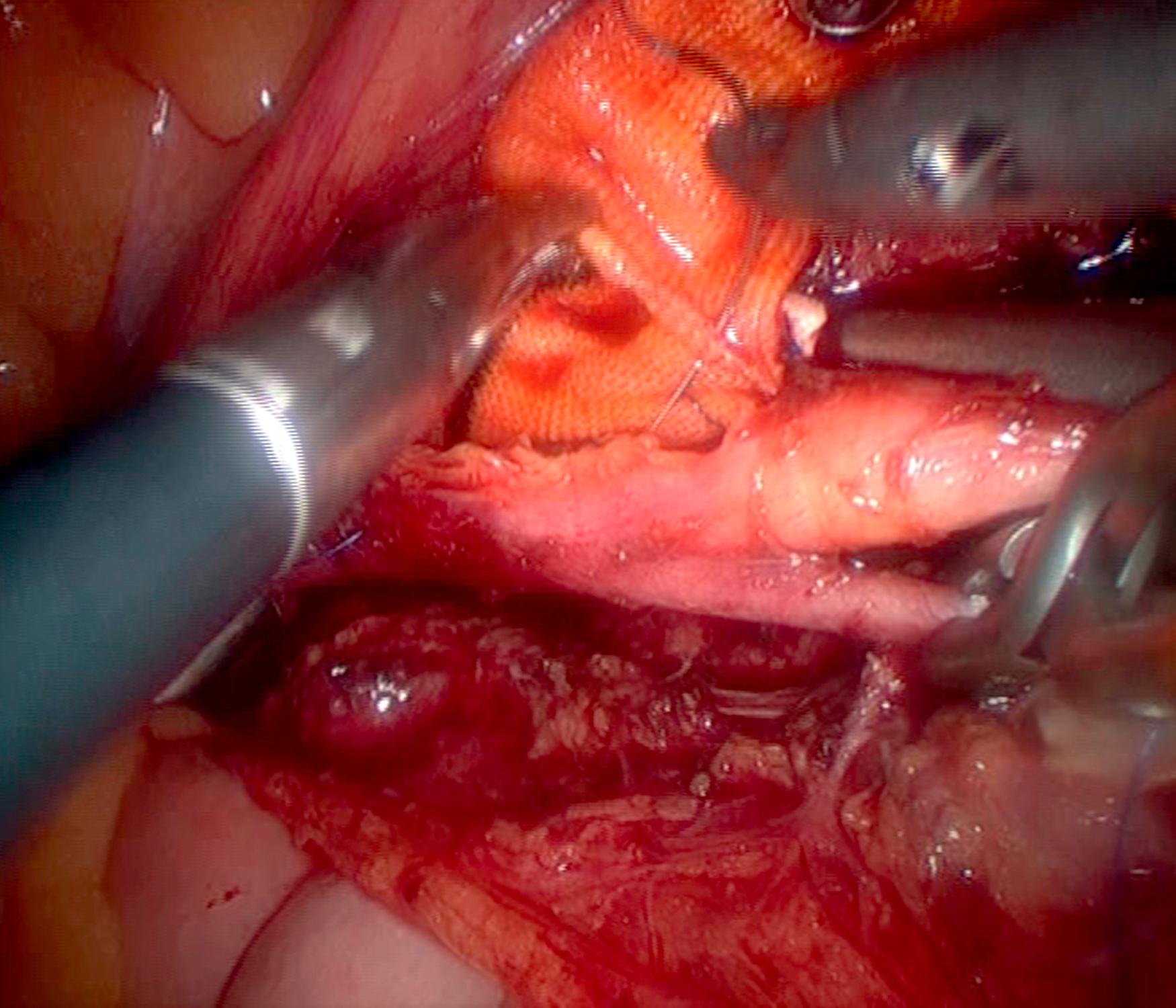
The left branch of the prosthesis is then tunnelled with the help of an aortic clamp introduced through the left groin. The tip of the clamp is located under laparoscopic control and routed behind the left ureter. Femoral anastomoses are performed conventionally on a patient in the dorsal decubitus position. After removing the clamp, the surgeon decreases the gas pressure to 6 mm Hg to check the hemostasis of the aortic anastomosis and to reveal any venous bleeding hidden by the high-pressure pneumoperitoneum. The mesocolon is then repositioned under laparoscopic control to separate the graft from the bowel. This retrocolic prerenal approach achieves an adequate aortic exposure and provides a large operating space with the small bowel falling to the right part of the abdomen and the left mesocolon acting as a peritoneal apron ( ![]() ).
).
Video 64.1A Total laparoscopic aortic surgery without robot: aortic approach.
The retrocolic prerenal transperitoneal approach is used in most standard cases of aortic occlusive disease. However, in very thin patients, where dissection of the Toldt fascia is impossible, or in patients with previous left kidney or colon surgery or for suprarenal aortic clamping, and in patients with an abdominal aortic aneurysm, a transperitoneal left retrorenal approach is preferred ( ![]() ). In these cases, the dissection is conducted by elevating the left colon and the left kidney with section of the reno-azygos lumbar vein to achieve a right medial visceral rotation.
). In these cases, the dissection is conducted by elevating the left colon and the left kidney with section of the reno-azygos lumbar vein to achieve a right medial visceral rotation.
Video 64.1B Total laparoscopic aortic surgery without robot: suprarenal aortic clamping for aortic occlusion.
The retrocolic retrorenal transperitoneal approach is used most often for total laparoscopic aortic aneurysm repair, particularly in patients with a juxtarenal AAA. After clamping the aorta, a stitch is placed into the aneurysm wall and pulled-out through the abdominal wall to maintain the aneurysmal sac open. The right iliac clamping is performed through an infra-umbilical trocar, and left iliac clamping through another trocar inserted in the left iliac fossa. A bulldog clamp serves to occlude the inferior mesenteric artery. Mural thrombus is removed in a container. Lumbar arteries are controlled with 3/0 polypropylene stitches as described in the Creech technique or by external hemoclips or staples. Anastomoses are performed as previously described.
This approach was first described by Dion. The main feature of the technique is the creation of a peritoneal apron that retains the intestinal loops without reducing the size of the operating cavity. A 10-mm trocar is introduced at the level of the umbilicus to establish the pneumoperitoneum at a pressure of 12 mm Hg. The patient is then placed in the Trendelenburg position at 10 degrees with the table tilted to the right. As initially described by Dion, the technique involved two distinct retroperitoneal and transperitoneal maneuvers for dissection of the left parietal peritoneum and attachment to the wall by three transparietal sutures to form a peritoneal apron ( ![]() ). The procedure begins with an incision of the left parietal peritoneum about 8 cm anterolateral to the Toldt fascia. Dissection is followed in front of the kidney up to the renal vein. The infrarenal aorta proximal to the inferior mesenteric artery is then dissected. The surgeon moves to the patient’s left side to complete the procedure. The apron is then attached to the wall to keep the bowel out of the operating field. As previously described, this technique was subsequently simplified by Coggia.
). The procedure begins with an incision of the left parietal peritoneum about 8 cm anterolateral to the Toldt fascia. Dissection is followed in front of the kidney up to the renal vein. The infrarenal aorta proximal to the inferior mesenteric artery is then dissected. The surgeon moves to the patient’s left side to complete the procedure. The apron is then attached to the wall to keep the bowel out of the operating field. As previously described, this technique was subsequently simplified by Coggia.
Video 64.1C Total laparoscopic aortic surgery without robot: juxtarenal abdominal aortic aneurysm.
This laparoscopic assisted technique with a short laparotomy to facilitate the aortic anastomosis was first described by Said et al. and developed by Edoga et al. for abdominal aortic aneurysm repair. The patient is placed in a right lateral decubitus position as for the retrocolic transperitoneal approach. The viewing endoscope is introduced through a 15-mm incision above and medial to the iliac crest using the open retroperitoneoscopic technique with a prior hand dissection of the retroperitoneal space. This dissection should be extended up to the midline to avoid peritoneal tears. Although rarely used, the retroperitoneal procedure is a suitable alternative when the transperitoneal procedure is contraindicated in patients with hostile abdomen or when a complete exposure of the left common iliac artery is needed. The main advantage of the retroperitoneal route is to exclude the visceral organs from the operating field albeit at the expense of a smaller working space with the risk of peritoneal tears. One reason that this approach is rarely used for aortoiliac procedures is diffusion of the gas through the peritoneum, thus creating a “passive” pneumoperitoneum which progressively replaces the pneumo-retroperitoneum, reducing the working space.
Hand-assisted laparoscopic surgery (HALS), which enables the surgeon to introduce his nondominant hand through a special port while maintaining the pneumoperitoneum, has been routinely used by some authors for aortic occlusive lesions or AAA repair. The patient is placed in the supine position. A midline incision of 7–8 cm is performed to allow placement of the port-site device. Through this port, the hand of the surgeon is introduced into the abdominal cavity without any carbon dioxide loss. A 10-mm trocar is then placed along the midline below the umbilicus with introduction of a 30-degree laparoscopic optic and for carbon dioxide insufflation to create a 12-mm Hg pneumoperitoneum. At that point, with the nondominant hand, the surgeon pushes away the bowel loops to the right by tilting of the operating table to the right and in Trendelenburg position. A trocar is then introduced lateral to the border of the left rectus abdominis muscle for dissection of the infrarenal aorta and another trocar is inserted lateral to the border of the right rectus abdominis muscle. After laparoscopic dissection of the aorta, the abdominal cavity is deflated, the special port-site device removed, the bowel being left in place in the right abdomen with the aid of laparoscopic sponges. The incision is kept open with an autostatic retractor. The proximal anastomosis between the aorta and the graft is performed under direct vision with conventional instruments. If a distal anastomosis on the external iliac is planned, an oblique supra-inguinal incision is done to expose the artery. HALS has proven in many studies to be a reliable technique to overcome the technical challenge of total laparoscopy aortic surgery, mainly the performance of vascular anastomoses. It may have increased the feasibility of this type of surgery but its invasiveness compared with total laparoscopic aortic repair is a drawback.
Become a Clinical Tree membership for Full access and enjoy Unlimited articles
If you are a member. Log in here